Luis Bunuel tells us that the comfortable man ( or woman ) , self-concerned, attempting to embrace more comfort, bores us stiff. And what Bunuel is telling us in cinema is what De Tocqueville forecast in “Democracy in America” . The scope of the individual has shrunk so that we can be interested only by looking at mankind as a whole. In the films of Bunuel the old self pursuing the old goals is unreal.
The great question is always when will we see new and higher forms of individuality , purged of old sicknesses and corrected by a deeper awareness of what all men have in common? Bunuel never really came up with a convincing demonstration of what these forms might be, though not for lack of effort. But neither on the other hand has anyone else. …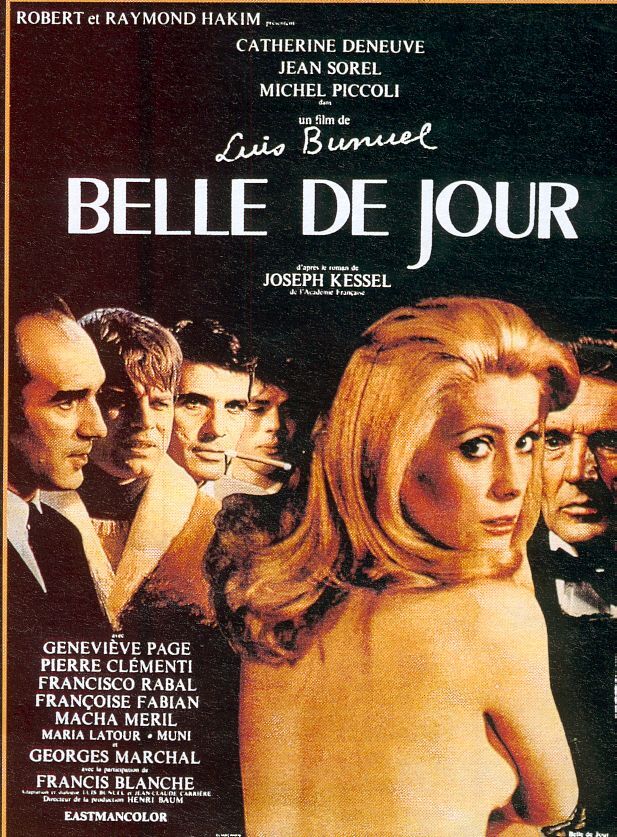
…Unreal City,
Under the brown fog of a winter dawn,
A crowd flowed over London Bridge, so many,
I had not thought death had undone so many.
Sighs, short and infrequent, were exhaled,
And each man fixed his eyes before his feet.
Flowed up the hill and down King William Street,
To where Saint Mary Woolnoth kept the hours
With a dead sound on the final stroke of nine.
There I saw one I knew, and stopped him, crying ‘Stetson!
‘You who were with me in the ships at Mylae!
‘That corpse you planted last year in your garden,
‘Has it begun to sprout? Will it bloom this year?
‘Or has the sudden frost disturbed its bed?
‘Oh keep the Dog far hence, that’s friend to men,
‘Or with his nails he’ll dig it up again!
‘You! hypocrite lecteur!—mon semblable,—mon frère!’ ( T.S. Eliot, The Wasteland )

Carlos Fuentes:If the end in a Buñuel film can mean exactly the contrary, the beginnings of his films can be terrifying. L’Age d’Or starts with a scorpion and that scorpion, encircled by fire, is committing suicide with its own poisonous tail. It is the center of a flaming eye. Buñuel has written: “The camera is the eye of the marvelous. When the eye of the cinema really sees, the whole world goes up in flames.
Simply put, its the competing visions of Hollywood and Europe. War of the same worlds.And at worst the narcissism of small differences.However, the influence of the Modernist sensibility on the International Art Cinema (IAC) cannot be overstated. Fueled by the writings of James Joyce, Ezra Pound and T.S.Eliot , and cubism movements such as Picasso and Braque and the Surrealism of Dali among others, Modernist thought after World War I challenged nineteenth century notions of a unified and stable reality, subordinating objectivity and reason to subjectivity and ambiguity.While Joyce, Eliot and Pound defined Modernist literature and jazz deconstructed popular music, Sigmund Freud and Albert Einstein brought psychiatry and science into the Modern World. Like Freud, the Modernist writers were convinced that mankind’s essence was inherently decentered and fragmented and that life itself was ultimately unknowable; but can be approximated, according to Bunuel through a social and collective reality or the acceptance of a child’s portion of our true condition.
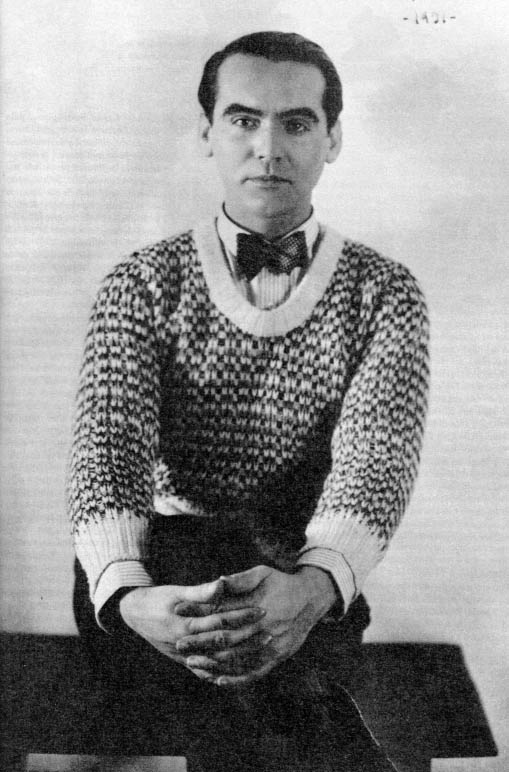
Frederico Garcia Lorca:"The story of Lorca's brief life (1898-1936) seems forever fated to begin with his death: ''Federico Garcia Lorca was thirty-eight when anti-Republican rebels in Granada assassinated him at the beginning of the Spanish Civil War in 1936.'' So begins, almost ineluctably, the introduction to Ian Gibson's rich biography of the great Spanish poet. Even in the most death-conscious country in Western tradition - where, as Lorca once pointed out, death is the national spectacle - his obsession with the subject was remarkable. In a poem written in New York in 1929, he predicted that he would be assassinated and that his body would never be found. On Aug. 19, 1931, he finished and dated an insistently death-centered, autobiographical play called ''When Five Years Pass.'' Five years later to the day a fascist death squad executed him and dumped his body into a common, unmarked grave. In 1934 his friend Ignacio Sanchez Mejias returned to the bullring after seven years in retirement, and Lorca knew intuitively the matador would be killed. When it proved true he told a friend: ''Ignacio's death is like mine, the trial run for mine.'' The matador, he commented, ''did everything he could to escape from his death, but everything he did only helped to tighten the strings of the net.''
Modernism explores identity through its inherent fissures and fragmentation. The Self is unstable and unknowable, and life is but a playing field for existential angst and alienation, a game of random chance. Modernism reflects a postindustrial cultural despair and exhaustion; a keenly felt loss, and perhaps recovery of religious faith. In the realm of film, Modernist schools of thought such as French Surrealism with Bunuel’s Un Chien Andalou, 1928,found their perfect modes of expression in the early silent cinema. Out of such works, and against the burgeoning and hegemonic Classical Hollywood Cinema (CHC) style, grew the International Art Cinema.
The IAC is inherently political due to its rejection of the CHC, a rejection not limited to style and narrative form, but one also marked by an aversion to the cultural domination and conservative ideology that Hollywood films trade in. By its very nature, then, the IAC is a political action, and as it seeks to address both the problems of the individual and the larger culture, it tends toward a liberal progressive stance. In Bunuel’s films the poor and humble are not invariably good, but he rarely finds any virtue or even firmness of character among well-to-do people. He remains an enemy of the bourgeois.
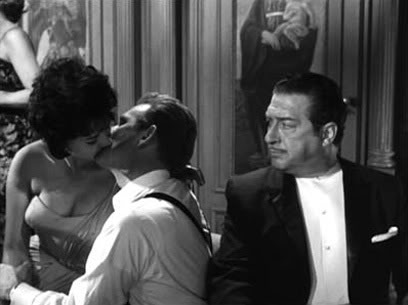
On Bunuel:"If he was a Marxist, he was certainly an excellent embodiment (and possibly a precusor) of the interest in Freud amongst European Marxists sparked off by the Frankfurt School. Dreams and dream logic are, in accordance with a certain Freudian tradition, beautifully interwoven in most of his films, so that the viewer often cannot tell whether he is watching a dream, reality, or a combination of the two. In any case, Bunuel's massive interest in Freud, his criticisms of Catholic morality (it's emphasis on repentance and abstinence especially) and his continuous fascination with the world of appearances and the substance beneath make him, in the film world, a veritable Socrates and a visionary. "
This political aspect, more often than not framed by WWII and/ or the Vietnam War, serves to support a variety of themes within the IAC. For example, As Fellini and Tarkovsky return again and again to the years of the Second World War, Godard’s work becomes increasingly radical after Paris’ class war in May of 1968 and his work begins to take on explicitly political themes. The leftist political tendency is one of the unifying values of the IAC. In “Stranger in the Room” an industrialist seduces a workman’s wife, fires the worker, she commits suicide; the worker, crazed with grief, comes to the industrialist’s house to kill him. There is a priest present who tries to reason with him, but what can a suffering worker have to do with the clergy, who eat dinner in the homes of the rich? He shoots the industrialist and later commits suicide.
Throughout the IAC there is an obsession with identity, schizophrenia, and multiple selves (Persona, 8 ½, The Mirror). But perhaps the defining feature of the IAC is the themes of religious belief, and disbelief, which are as vital here as in the Modernist literary tradition. Such crises of faith consistently appear in these films, and might be considered the single unifying theme of the IAC. The International Art Cinema continues to provide n
orms of storytelling which challenge the fixtures of the Classical Hollywood Cinema. The narratives of the IAC are often baffling; poetic in nature rather than novelistic in the classical sense. In “Vridiana” , the would-be-saint and the young priest in “Nazarin” apply their Christian measures to the realities of human nature and the facts of money and power. Violent truth sobers the priest; it sends Viridiana spinning into sensuality.
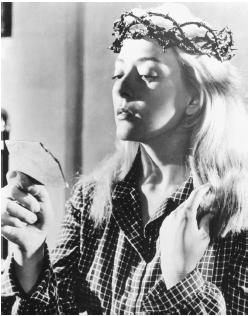
Viridiana. Among those seeking sainthood or martyrdom in traditional form he sees only illusion; not sacrifice, but a perverse desire for pain; not love, but self-will.
The disjointed narrative form of IAC derives from a Modernist tradition of fragments, conflict, cacophony, montage. It is ambiguous, puzzling, metaphorical, as opposed to literal, and exhibits a contrast between the subjective and objective. It stands in opposition to the conventions of classical narrative structure. The purposes of IAC narrative are different than those of Hollywood films. The IAC is reflexive, political and subversive, cerebral and associative, poetic rather than realistic. It celebrates chance and randomness rather than a mechanistic cause and effect. It asks to be read vertically as opposed to sequentially. To read the IAC requires a break with the conventions of Hollywood cinema.
Oliver Stone’s sequel to “Wall Street” is example of the Hollywood genre pushed to its logical conclusion which is a capitulation to auto-destruction in the face of negating the “happily ever after” narrative: the apotheosis of the American version of the counter-reformation of cinema. From Stephen Marche:
George Orwell had a great description of the British ruling class during the last years of its empire, and it reminds me exactly of what Oliver Stone has been up to lately: “Clearly there was only one escape for them — into stupidity. They could keep society in its existing shape only by being unable to grasp that any improvement was possible.” The decline of the American upper class over the past thirty years has followed the same trajectory, and Stone — the self-hating aristocrat, the Ivy League dropout who dropped the most out, the man who blamed the “Jewish domination of the media” for a collective failure to put Hitler “in context” — is the perfect encapsulation of that decline. His movies reflect the worst instincts of his generation: intellectual laziness leavened with narcissism and easy entitlement integrated with casual irresponsibility, and his latest movie, Wall Street: Money Never Sleeps, is a kind of perverted homecoming for him. It establishes Stone, yet again, as one of America’s most delicious poisons, a vicious mix of naivete and cynicism, patriotism and paranoia, self-righteousness and self-loathing. His flaws are our flaws. His stupidity is the stupidity all around us. And there is a decent chance he’s finally lost his mind.”
In real life there is no beginning, middle and end. Life is episodic and fragmented. The only realistic view, then, is one that is personal and subjective. To convey this interior realism, characters often appear to drift through their stories in a sort of dreamlike trance that defies temporality, as in the films of Bergman (Wild Strawberries, 1958); Fellini (8 ½, 1963), Godard (Weekend, 1968), Andrei Tarkovsky (The Mirror, 1975) and countless others. Not only is time free-floating and nonlinear, but the characters themselves are often fragmented and ambiguous. The inner life is a powerful force and not necessarily within our control or comprehension. The IAC demands that the viewer play psychologist in order to interpret the work. Films that invite interpretation, but maddenly defy conventional forms of analysis, which is to be expected when the challenge of the narration is the articulation of the inarticulable.
The IAC narrative form is unabashedly aware of CHC, acting as a counterpart to it. Unlike Hollywood films, IAC is a reflexive art, acknowledging itself as a part of a tradition of history and popular culture (including the CHC). The art cinema is full of references to other works of art and is often filtered through the painful memories of WWII in the 1950s and through the reality of the Vietnam War in the 1960s. Such concerns and preoccupations inevitably find their way into the narratives of the IAC and inform the films thematically as well.
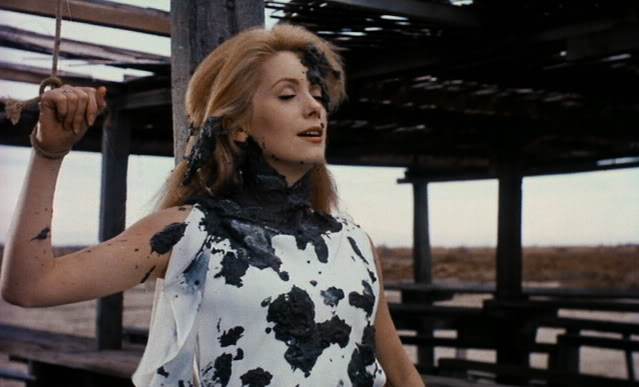
"... The fantasies often show Séverine as bound and being defiled. But instead of punishment - again, too easy to interpret her restraints as representing something other than literal ones - she's shown as enjoying the act. Séverine stands in virginal white as men pitch mud/shit at her; Deneuve's vanilla mug smiles as the slop hits its mark. The film's libertine character - Michel Piccoli, who pursues her wanting to smudge her innocence, loses interest when he learns of her day job - matter-of-factly points out to her, "You like being humiliated." It's not a prescription she could have understood herself without venturing outside her marriage. (According to Julie Jones' DVD commentary - which takes turns being insightful, overreaching, and redundant - some critics also explained away the film's whorehouse sequences as fantasies. The filmmaking doesn't suggest this, though. Besides, it would deny Séverine the pleasure of her actions, would rob the movie of its teeth.)"
…In Viridiana, Don Jaime lives alone in his manor. His wife died from a heart attack on the wedding night. He has paid the gift and education so that his wife’s niece Viridiana could become a nun, and wants her to visit him for a few days before she takes her final vow. She strikingly resembles her aunt and is persuaded to take on her wedding dress. Then he asks her to marry him. When she refuses, sleeping pills are put in her coffee. Jaime only decently fondles her. On the next day she leaves but is brought back by the police. Jaime had made a trap that might lead to another marriage. He acknowledges his “bastard” son Jorge, writes a will making his manor the common property of him and Viridiana, and hangs himself….
In evidence in “Viridiana” are Bunuel’s various fascinations and obsessions: with Freud’s essay on the Uncanny, including doubles; with deviant sexuality and sexual obsession; with extreme and often inexplicable violence; with satire of the upper and middle classes and the church; with the music of the Romantics; with the Marquis de Sade’s and the Old Testament’s imagery; a clear-eyed, sympathetic look at the struggles and suffering of the poor. The film makes obvious Bunuel’s entry into the Surrealist group in Paris in the 1930′s which included Andre Breton, Louis Aragon, Max Ernst, Picasso, and Marcel Duchamp and Man Ray, both of whom also made a few excellent short films in the same period.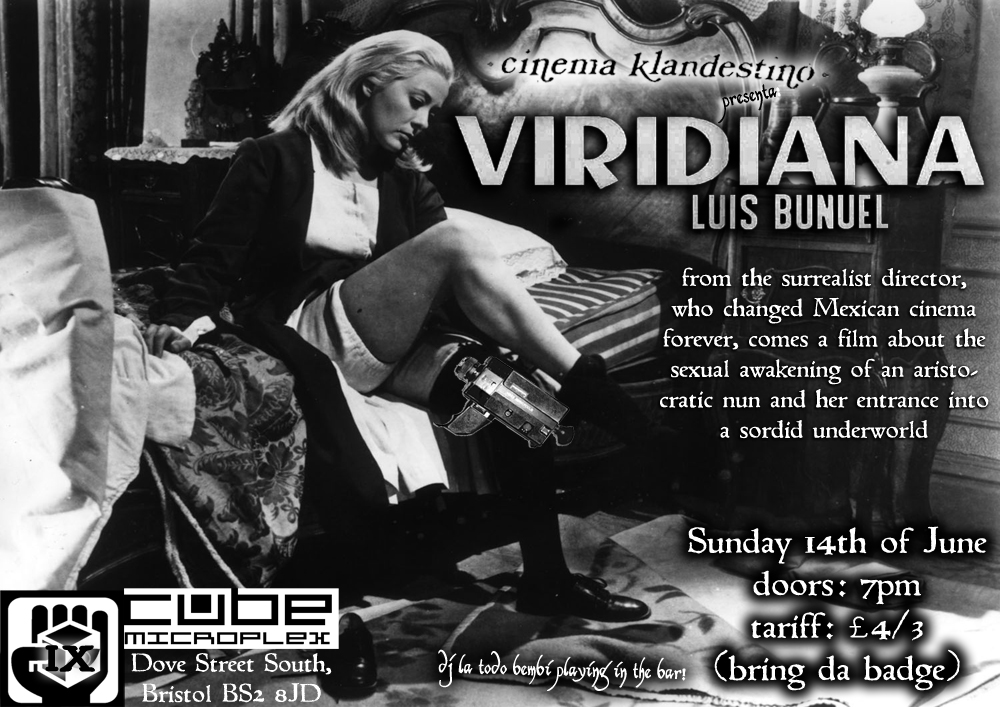
“the search for truth, as well as the necessity of abandoning it as soon as you’ve found it.” In this case, although the film is quite comedic, this truth is rather harsh: the bourgeois characters are silly, self-involved and superficial, though they do have intermittently attractive qualities. It is interesting to ponder that many people have referred to Bunuel as one of the most religious of filmmakers, even though half his life’s work is explicitly making fun of the Church.
“…I’ve learned from Baxter, an active gay basher in his youth, and those who’ve read the untranslated but reputedly fascinating memoirs of his widow report that he was a very old-fashioned and prudish male chauvinist throughout his life. He was a onetime devout Catholic who lost his faith in his youth and was fond of exclaiming years later, “Thank God I’m still an atheist!” Yet Orson Welles, who never met him, may have had a point when he said, “He is a deeply Christian man who hates God as only a Christian can, and, of course, he’s very Spanish. I see him as the most supremely religious director in the history of the movies.” He added, “A superb kind of person he must be. Everybody loves him.””…
“In Viridiana, Bunuel casts doubt on both the value of spiritual beliefs and on the purity of the central character’s motives. But, he does not discuss God, but the way God is worshiped. He was greatly criticized at the time for showing a crucifix that turned into a pocketknife, yet this was a common souvenir that could be bought throughout Spain (although not after Viridiana!) Raised as a Catholic (although often quoted, when asked his religion, “I’m an atheist, thank God!”) he firmly believed that sin multiplied the possibilities of desire.
“An artist cannot change the world. But, they can keep an essential margin of non-conformity alive.” Luis Bunuel.
“When I was younger, my so-called conscience forbade me to entertain certain images—like fratricide, for instance, or incest. I’d tell myself these were hideous ideas and push them out of my mind. But when I reached the age of 60, I finally understood the perfect innocence of the imagination. It took that long for me to admit that whatever entered my head was my business and mine alone.” ( Luis Bunuel, My Last Sigh )
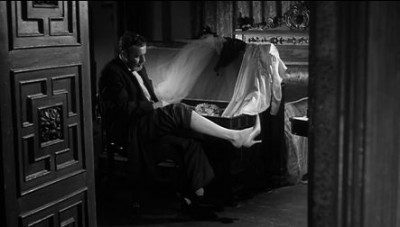
----Viridiana goes to her room to change and rest. The camera moves into Don Jaime’s bedroom, where he has a white, high-heeled shoe slipped over the top half of his foot and a veil draped over a dressing screen. He picks up a corset and starts to model it in front of his mirror, quickly tucking it out of sight when the loyal Ramona comes in. He tries to persuade Ramona to speak to Viridiana on his behalf, to ask her to stay on at the house indefinitely. Ramona demurs, suggesting Don Jaime speak to her himself. He moves to her room, but hides out of sight when he sees Viridiana disrobing. In one of Buñuel’s patented leg shots, she removes her thick, dark stockings to reveal a very shapely leg.---
Luis Buñuel was 61 when Viridiana premiered, and his tale of sexual perversion and the deflowering of a would-be nun bore out his philosophy to a tee. Many of Buñuel’s films rail against the hypocrisy and uselessness of the bourgeoisie, the Catholic Church, and the State. While these themes remain fairly constant throughout his genuine oeuvre , some of his films are informed primarily by his surrealist philosophy, and reflect his lifelong fascination with dreams. Viridiana is just such a film.
The Surrealist Revolt lent a death blow to all notions of coherence and with it the entire architecture of traditional thought. The genesis of Surrealism can be traced to Dadaism and Breton’s Surrealist Manifesto which advocated Freudian free association of dreams, illusion, reality and chance. The contextual, conceptual and formal qualities shared by Breton’s 1924 Manifesto on Surrealism and Bunuel’s surrealist films forms an important fulcrum to understand the matrix between Surrealism, ideology and psychoanalysis that forms the backbone of much of Bunuel’s cinema.
Viridiana (Silvia Pinal) is a novice in a cloistered convent. Shortly before she is to take final vows and be locked away from society forever, the Mother Superior suggests that she pay one last visit to her uncle Jaime (Fernando Rey), who paid for her schooling. Viridiana strenuously resists this suggestion, but says that if ordered, she will go. This scene is the first to suggest the dreamlike structure of the film, with a resistant consciousness obeying an order to plunge into the irrational.
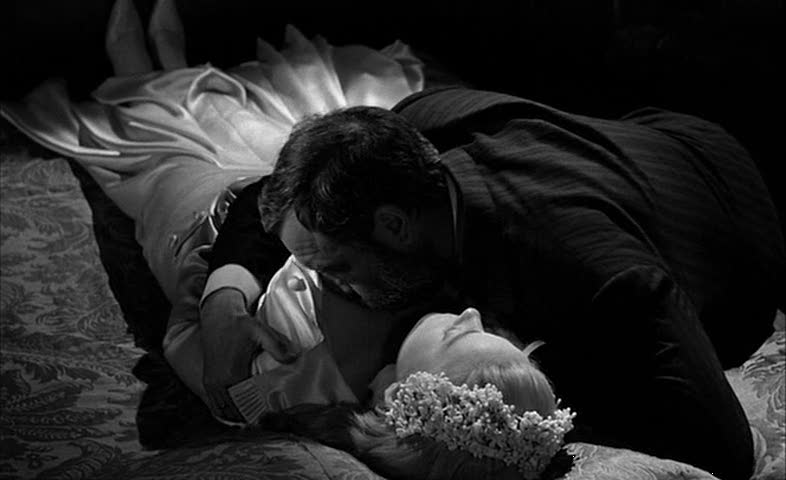
With Ramona’s assistance, he eventually persuades Viridiana to do him one last favor—don his dead wife’s wedding gown. Apparently, Viridiana was moved by the story of his wife’s death in his arms on their wedding night. However, she is repulsed when he proposes marriage to her. This refusal is Ramona’s cue to drug Viridiana’s tea. Don Jaime lays her out on a bed, intending to rape her. He unbuttons her top and kisses her passionately, but shies from the deed itself. When she comes to in the morning, however, he lies to her and tells her he has ruined her so that she can never return to the convent. Her disgusted rejection of him pushes him to suicide. In a scene of obscene hilarity, Rita is shown playing with the same jump rope Don Jaime used to hang himself.
…After her uncle has hung himself, Viridiana inherits half his estate with the other half going to his natural son Jorge. Penitent, Virdiana tries to expiate her sin of withholding forgiveness from her wretched uncle by filling the estate with as ugle a crew of paupers and beggars as she can gather, and to these nasty sinners she devotes herself with saintly piety; but we quickly understand, as does Viridiana’s mother superior, that she is a proud rebellious girl, a kind of Protestant who gives supreme authority to her own conscience. This second, Franciscan phase of her saintliness is shattered by the beggars and by her cousin Jorge.
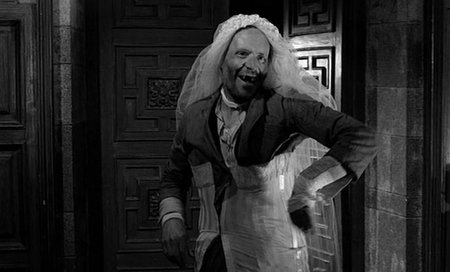
Marilyn Ferdinand:One night, the owners of the estate must leave for town. The beggars become curious about the main house and sneak in. They kill a couple of goats and have a feast, soiling the expensive lace tablecloth, breaking the crystal and china, and making love behind the furniture. In a grotesque parody of Don Jaime’s earlier scene, the syphilitic beggar dons the dead wife’s corset and her veil and dances an obscene jig. One of the women urges them to assemble for a photograph. The tableau they create is one of the greatest visual gags in cinematic history. When the masters of the house return, the beggars vanish from the house or remove themselves to other rooms. Two of the beggars overpower Jorge and rape Viridiana. With her ideals in tatters and her sexual nature awakened in an archetypal way, Viridiana is both freed and imprisoned by her new, worldly impulses.
Jorge is a brisk , modern, masterful young man from the big city, who brings his mistress to the estate with him but is willing to ditch her for Viridiana, if he can get her, and for his housekeeper in either case. When the master leaves the estate briefly with Viridiana, the beggars get into the house and give themselves a banquet, which turns into an orgy of drunkenness, gorging and copulation. They have themselves “photographed” in a travesty of “The Last Supper” by a gypsy who snaps the “camera” by lifting up her skirts.
When Viridiana and Jorge return unexpectedly to the house, he is caught and bound while Viridiana barely escapes being raped by two of her poor, one of them a syphilitic. Her second venture into sainthood thus ended, Viridiana exchanges her piety for a sensual life with Jorge, whom she will have to share with the housekeeper. All three sit down to play cards to the loud banging of rock-and-roll music. This last scene suggests the room in Sartre’s “Huis Clos” in which two women and a man are shut up in eternal hell.
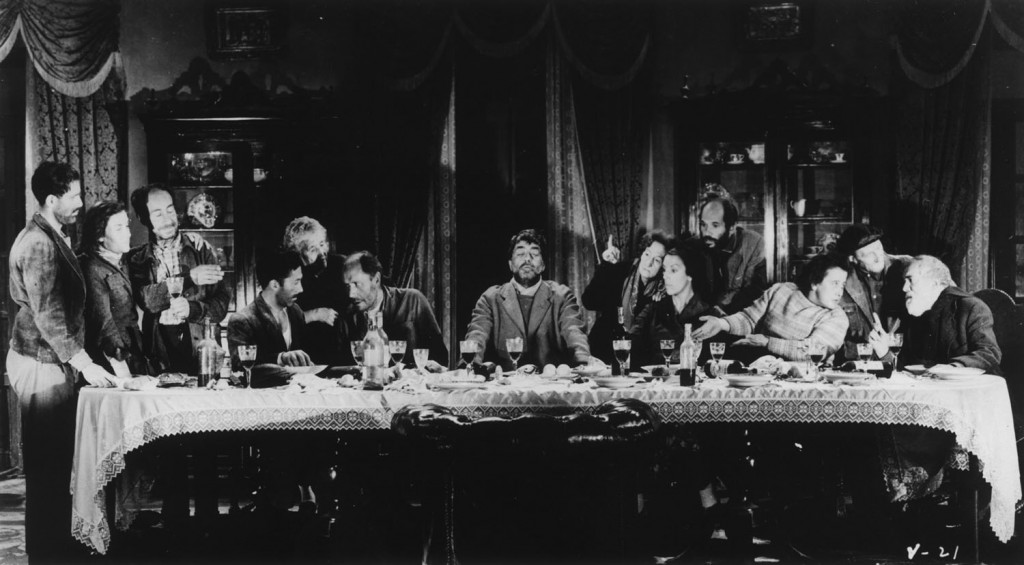
----"In Viridiana, Buñuel's humor is, as usual, subtly (sometimes not that subtly) mordant, though the film isn't exactly the type that'll make you pee in your pants laughing. That said, there's a very good chance it'll elicit chuckles here and there, in addition to either gasps or applause (quite possibly both) at the filmmaker's daring — including the infamous dinner-table sequence in which the local rabble is portrayed like Christ and the apostles in Da Vinci's "Last Supper." (My favorite scene in Viridiana shows an obnoxious little girl jumping rope — a rope had just been used for a suicide.)----"
ADDENDUM:
“Most obviously, this subversion of the darker side – or should I just say human side – that lies below the surface of good acts and intentions is made evident in the scene of the beggars banquet itself, which, contrary to thoughts of blasphemy, is actually much less cynical than it appears and, as the Jesuit priest suggests, perhaps shows Buñuel’s humanistic side. By placing the beggars in a representation of the apostles, like Caravaggio’s use of prostitutes and beggars in his religious paintings, he robs the scene of its heavenly religious aura and reminds us of the human qualities that lie behind them. Is it blasphemous? Hardly. Iconoclastic, certainly – Buñuel seeking to offend and challenge people’s comfortable illusions and unthinking religious beliefs, exposing the hypocrisy that lies beneath them. These are real people, with real flaws and real problems and Buñuel uses real beggars rather than actors and makes us confront them. Does their presence on the screen and their behaviour offend us? How much are we willing to forgive their behaviour, their ugliness, their coarseness and their poverty? Are they also not just as welcome at God’s table? Well, since the film was promptly judged immoral and banned by the Vatican, evidently not. Buñuel could surely have expected nothing less. ”
…This alteration of dream and reality, the ‘real’ and ‘unreal’ subverts the kind of coherent referential meaning we expect in Cinema and defines the non-habitual rhythms of his radical work. The essential attempt is to explode what Walter Benjamin calls “the continuum of history” and wring mankind away from the conformism which threatens to overwhelm entire civilizations. Bunuel attempts to show how bourgeois concepts of self are as systematically destructive of human freedom and delimiting as Nazi death camps. The cyclical form questions stratified structures, what Jacques Derrida calls “violent hierarchies” in a way that does not present a Utopic world which moves beyond these distinctions. Instead Bunuel addresses these historical power imbalances by thinking through dominant concepts and presenting complications to show the contingency of stratification.
Similarly, the aesthetic is colored by a realization that the world has no fixed centre, a realization often associated with post-modernism. The spatial model of the labyrinth is followed as dreams are embedded within other dreams. The perfect example perhaps is The Discreet Charm of the Bourgeoisie where one of the characters wakes up to tell his wife “I was dreaming, no I was dreaming that Sénéchal was dreaming”. After a while it becomes impossible to determine whose dream it is? Where does dream end and reality begin? It is this unification of interior and exterior reality that Breton envisages as the final aim of Surrealism, or what he called “surreality”
“I believe in the future transmutation of those two seemingly contradictory states, dream and reality, into a sort of absolute reality, of surreality, so to speak.” (Breton )




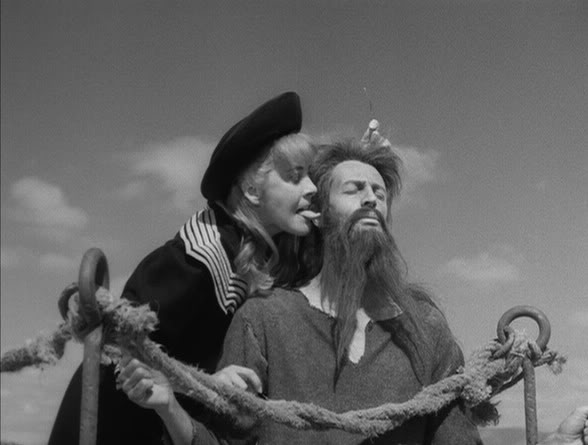




 COMMENTS
COMMENTS



